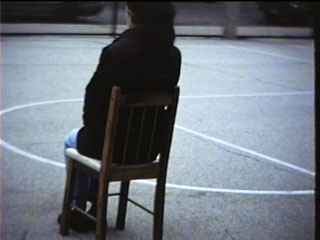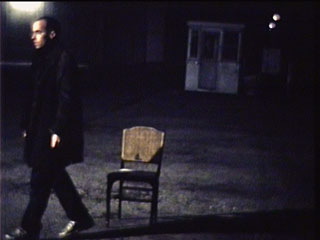 that are not really urban places but which were claimed as public spaces during the performance.
that are not really urban places but which were claimed as public spaces during the performance.


Place and Space is a video and sound installation.
Place and Space was first shown in 1926 Gallery in Chicago in Dec. 2000.
Place and Space is a collaboration among eight artists who performed and collected sound in eight places of their choice in Chicago; open spaces  that are not really urban places but which were claimed as public spaces during the performance.
that are not really urban places but which were claimed as public spaces during the performance.
Place and Space addresses questions of vanishing public space in the city. In our time, the evolving of “Megacities” (Saskia Sassen) and “Edge Cities” (Joel Garreau), and the changing of the relationship between landscape and cityscape, “Zwischenstadt" (Thomas Sievert) has rapidely changed the relation of the individual to what had been urban space (R.Sennett), and thus the “production of space” (Henri Lefebvre) has raised new issues: Is there still public space in our cities? Is public space vanishing? Do we have to find a different notion of public space? Or does the public have to claim space in the city in a different way? (Does the public still exist?)
Place and Space is a work being created by Klaus W. Eisenlohr. It tries to achieve formal qualities of simplicity, media and material coherence and internal logic, i.e. aeisthesis. It originated in sound and 16mm film footage, transferred and edited on a non-linear video editing system, projected as ephemeral images on glass. The way it is presented, the pictures almost lose any materiality, but on the other hand they claim and create their own space in the gallery in a way that the audience is forced to interact with. It is thus both, “beautiful and disturbing.”
It originated in sound and 16mm film footage, transferred and edited on a non-linear video editing system, projected as ephemeral images on glass. The way it is presented, the pictures almost lose any materiality, but on the other hand they claim and create their own space in the gallery in a way that the audience is forced to interact with. It is thus both, “beautiful and disturbing.”
Place and Space is to be installed in a gallery space of variable dimensions. It can be installed in a way that is open to interact or overlap with other, different works as long as there is a low-light situation.
Place and Space consists of 4 free standing screens of 20"x15"inches on the floor of the exhibition space and four mini-projectors with a projection distance of 4 feet. The screens are arranged in diverse directions in the space. The audience has to walk in between the screens in order to pass throughthe room or to see all four projections. The audience has also to be careful with their steps as the the screens are rather fragile and “vulnerable” (though they are less fragile than they seem to be).
During the reception one of the performers (one at a time) who is represented on one of the screens will enter the space and sit on a chair, and then silently change places for about 10-20 minutes in between audience members.
| back | images from the show |